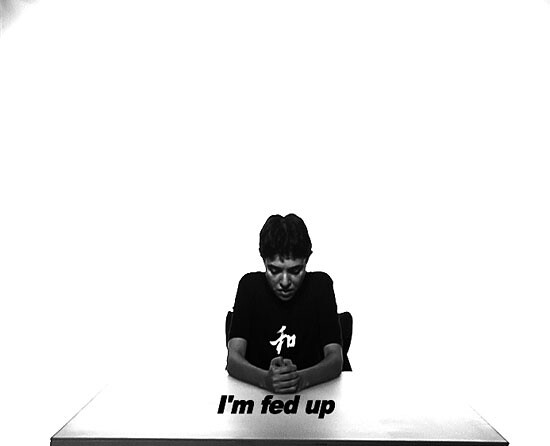

1A. This white space is a stage—a platform that highlights and draws out a set of material conditions and coldly inspects them. This virtual space is inhabited by an androgynous protagonist with a specific sense of fashion. The figure is the subject, is the engine that powers this investigation—our focal point, the site through which a concept can be allowed to appear. The ground is the context—the white space, the white table, the stage of phantasms. The subject is enframed, is charged with a concept of a self, of a persona performed. This space is a metonym—a moment that partakes in a condition, a fragment rather than a symbol standing for something else.
Here, everybody rants the secret moment.
1B. How do we survive the poisoned glance, the uncomfortable handshakes, the innuendos of undeserved arrogance? We might recognize that introverted scenes produce bile and hysterical defensiveness, yet we remain unable to discover alternatives—this is not that alternative, but only the chance to go into free fall. We begin with a scene at the end of its limits—a scene unable to go beyond the sound of its own insecure high-pitched neurotic voice, a scene on the brink of implosion. The members of this scene are stuck between a craving for validation and approval and the fallout that accompanies unrequited desires. The individuals belonging to this group have to live off two systems at the same time, all further complicated by the specificity of the scene’s own demand for validation (distinct from the demands of the individual member), and thus we get the hustlers and liars who all want a piece of the cake—those willing to market their backgrounds to the nth degree to the lazy smug self-satisfied arrogance of an international counterpart that is still not able to come to terms with what the “flow of information” really means.
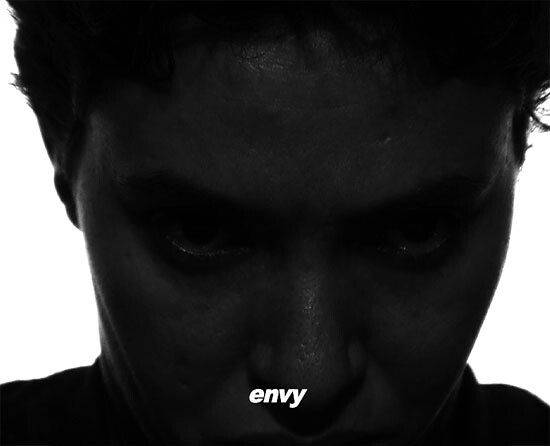

2A. A rant is a hyper-expressive condition—utterances shoot out at an accelerated pace, the subject’s delivery outstrips its desires, the expression is caught up in its own presence and fails to reflect one’s intention, hence the stutter and the breathlessness of hyperventilation. We are therefore always one step behind. Here, what would normally take less than a minute is slowed down to a dense narcotic six-minute confessional and stylized disclosure. The rhetorical construction of a speech act unfolds over a numbed-out musical composition. Although the nature of causality treats each utterance as more than only itself, we have here a syntagm that derives its polyvalence from its material conditions—from the conditions of its appearance.
2B. In this scene, personal relationships are self-righteously confused with professional ones—every participant is placed under the regime of a moral conformity in which the gestures of political engagement and high-level personal bickering become more or less the same thing. A demand is therefore made on every participant, every unwitting masochist, to perform the rituals of allegiance to the master order of the set. Trapped in a vertiginous spiral, we seek the glamour of a moment as our only salvation. The performances of belonging promise but never deliver. With pleasure, we watch friends, competitors, and enemies writhe in poorly concealed discomfort. The emotional conditions that rule the relationships built within that scene are by necessity thus polarized. We have a contradiction that is not just an arrested moment, but a contradiction that is about structure rather than appearance. Thus, negotiation is key.
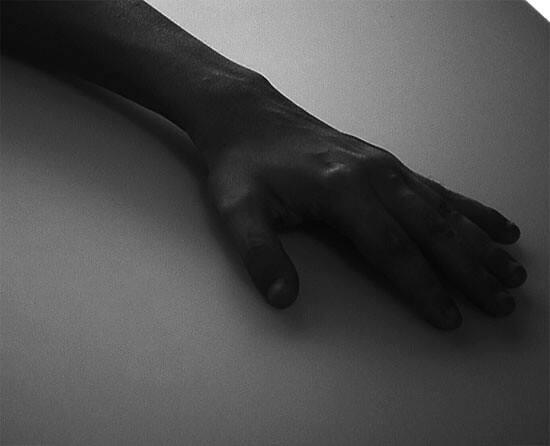

3A. The isolated details that punctuate the confessions of our protagonist are reminders of a biological reality—a presence that is not merely a material condition, but also a symptom of that condition. The condition however remains mystified, and we are left with only traces of a presence—the weight of an arm resting on a table, the piercing gaze of an eye. The subject is specter-like, with no real solidity, and the protagonist thus has no interiority, no exteriority—these words become linguistic tropes rather than actual dimensions. The protagonist is only a cipher for a set of existing relationships—a cipher defined by the impossibility of possessing interiority with its own fully valid independent voice. The subject is a product, a surface, which demands new framing devices. These are not just aesthetic choices—they are strategic necessities.
3B. The actions of the ruthlessly ambitious demand a price that not all are willing to pay. However, in such a space choices are limited. Performed gestures of bonhomie and camaraderie go hand-in-hand with the well-placed whisper, the sidelong glance, and the half smile. The emotional mess of raised voices, boasts, half-truthful claims around the post-opening dinner table is only one more thing to get through. But more importantly, what kind of aesthetic choices do these conditions lead to? Something must be fetishized, and in this case the easiest target is the softest one. Thus the downtown cosmopolitanism of the hustler, the obsession with the nostalgic chandelier, the superficial binaries of contemporary and authentic, and most of all the insistence that contradictions exist—these are all maladies related to this condition.
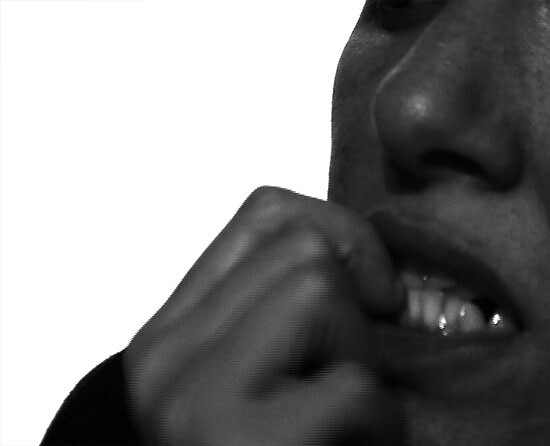

4A. The rant is a literary form that finds its specificity in its own excess. The more one rants, the more the rant comes into its own. This is a form that is always about convincing oneself of oneself, just as it is about convincing itself of its own discursive formation. It is an argument that begins and ends with the self—a monologue that spirals inwards towards an anticipated yet feared apocalypse. We tremble between two posited spaces—what for argument’s sake we will call external and internal spheres, divided by a thin skin. The laceration of that skin, a form of self-mutilation, is the trace of that tremulous state of being. The blaming of the self, a sense of inadequacy, an insecure, vicious fragility, are the first steps towards an overblown, yet fully operational persona.
4B. It is possible that we are all caught up in a vortex driving us towards a moment of silence in which the ego ends as our careers die. What can easily drive us insane is the continuous insistence by members of the group to sell something based upon a valency that ultimately devalues the self itself, both confirming and ignoring the truism: “We do not provide services—we are the service itself.”
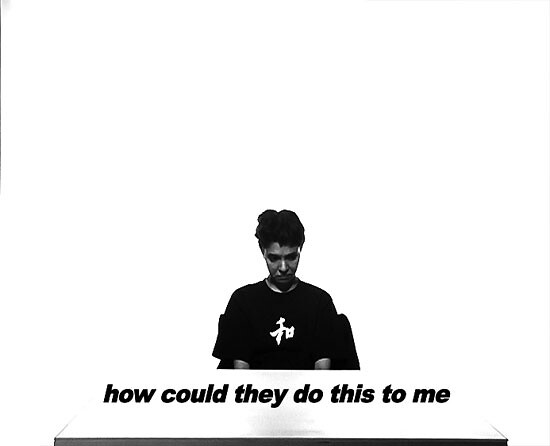

5A. That choreographed and slow collapse is predicated on a question that is also a statement. The question/statement formalizes a schizophrenic sensibility—what is not to be represented, what one can only engage with. The visual code through which a generic speech pattern can be formalized will thus by necessity be stylized. The rules that determine this relationship ensure that our identification with the subject is not a sentimental one achieving catharsis, after which one can drag with relish on a post-coital cigarette. Here, we must be willing to pounce upon the weakness of the victim. Here, the victim is the predator.
5B. The inability sensed by members of this group—that elusive slightly worrying sensibility—is based upon the inability to grasp how a system can never function only as an image of itself. Like all good neurotic subjects, the members of this scene are enamored with theatrics, with atmosphere, with the image of a wounded fragile ego on the brink. This is best expressed by the continuous litany of complaints that most seem to indulge in with great pleasure. Latent, yet quite visible, is the need for self-affirmation. Unfortunately, the specificity of our industry—one in which commodity derives its value, at least in part, from a mystified diffused ambience—only enhances that reified abstracted sense of alienation. For this we have absolutely no sympathy.
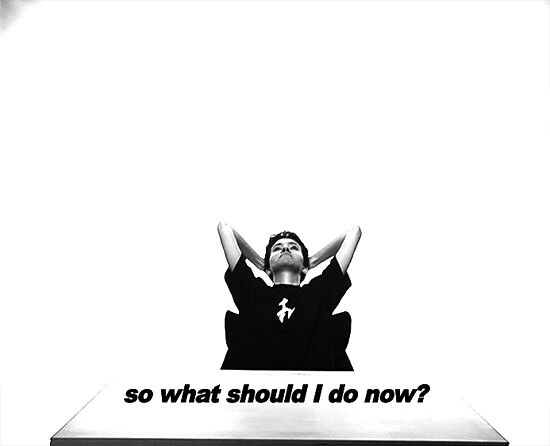

6A. For a brief moment we come close to an actual resolution in a full, almost Marxist sense. Our subject recognizes the necessity for action and comes closest to transforming into a protagonist possessing subjectivity. The question of the artist’s agency, the recognition of the self as a subject in the first place, has been systematically misrepresented as a quest for a transcendent and ennobling endeavor. Posing the question is never enough to achieve this form of separation. The question the subject poses with resignation here remains trapped in its space—static and driven by the ultimate desire to belong.
6B. The question of the artist’s agency—how the artist can act and what the artist can do—becomes important here. We do not prescribe organized political action (that’s what curators or artists who think they are curators would by necessity do), but rather we call for a reactionary focus upon one’s own work mixed with the dangerous possibility of a brutal yet fully disclosed self-interest as one possible path. Maybe what one romantically yearns for is a return to the work.
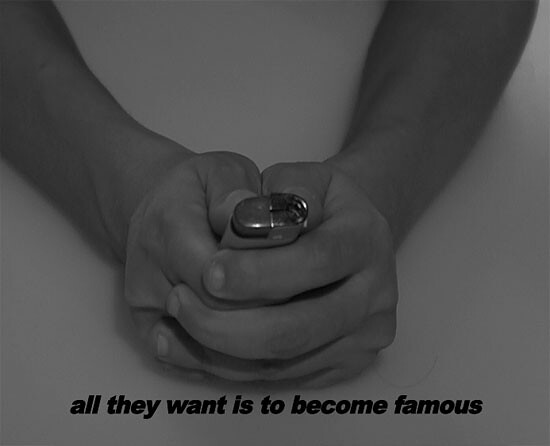

7A. The lighter that appears near the end best encapsulates the subject’s struggle with the limitations of its own rhetoric. The lighter is the product as manifestation—an external object that materializes the abstract and internalized conditions of the subject. The lighter here is another micro-metonym—a decoy. The watcher expects the subject to use the lighter in some sort of highly destructive fashion, this never happens. The generic codes of suspense and melodrama help bracket the voice through which the work becomes comprehensible.
7B. The question concerning the location of this moment within a social and professional scene forcefully demands an answer. Rumors are a strong contender for the distinction of becoming that liminal space. For example, a curator or artist bitching to a colleague about an absent third colleague is maybe in the end only trying to inspect these conditions, but also ultimately failing, tragically.
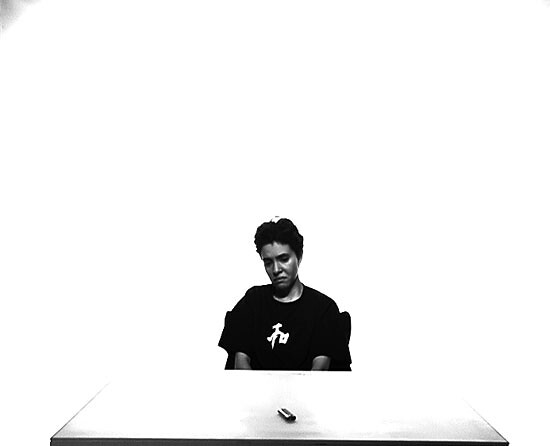

8A. The protagonist gently and precisely offers the lighter to us, the invisible watchers, while regarding this offering with a conflicted expression. Rhetorical actions reach their conclusion at the moment when the self can return to some kind of primary gaze—when subject/object binaries are reestablished, when the persona becomes stable. This coda is however corrupt and lacking in resolution and closure.
8B. Have you ever noticed how the gatekeeper always wants meetings to take place in their space? The gesture itself already determines where the subjects who share that space stand in relation to each other. One suspects a deep relationship between the “generous” gestures of liberal inclusion and the deeply loved myth of the nobility of our group endeavor. The members of this group love to foster the illusion that we are together deeply involved in some collective humanist project. Maybe the first and most important step is to drop that destructive illusion.
Rant (2008) is a single-channel video that premiered in Cairo as part of Lapdogs of the Bourgeoisie, an exhibition curated by Nav Haq and Tirdad Zolghadr. For the project, I worked with actress Roba El Shamy for an intensive period of time in which we explored her relationship with her professional milieu. The result of this investigation was a stylized actor-driven video work accompanied by a piano composition by the artist. All images from Rant, single channel video and music composition, 6’45”, 2008, courtesy the artist and Galerie Chantal Crousel.

